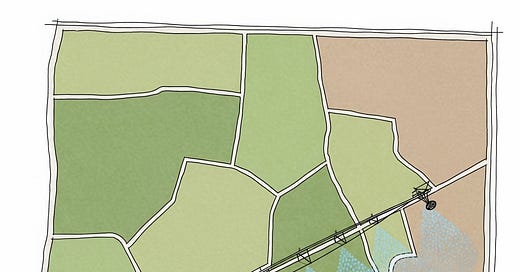Variable Rate Irrigation (VRI): Tailoring Water to Field Variability
Watering Smarter, Spot by Spot: Giving Each Part of Your Field What It Needs
On many farms, fields aren't perfectly uniform. Some spots might have sandy soil that drains quickly, while others have heavy clay that holds more water. There might be high spots that dry out faster or low spots where water collects. Traditional irrigation systems treat the entire field the same, leading to wasted water in some areas and underwatered crops in others. This is where Variable Rate Irrigation (VRI) comes in, offering a precise solution to match water application to the specific needs of each part of your field.
What is Variable Rate Irrigation (VRI)?
VRI is a advanced irrigation method that allows you to change the amount of water applied within a single field. Instead of applying a uniform amount of water everywhere, VRI systems can adjust the water output based on the specific requirements of different zones or sections of your field.
Think of it like this: Instead of painting a whole wall with one brush at a constant speed, VRI lets you use different brush sizes and speeds for different parts of the wall, ensuring each section gets just the right amount of paint.
How Does VRI Work?
VRI systems typically rely on a few key components:
Zone Mapping: First, you need to understand the variations in your field. This is done by creating detailed "zone maps." These maps are based on data from:
Soil Sensors: Measuring moisture levels at different depths.
Yield Maps: Showing historical crop performance across the field.
Aerial Imagery: Using drones or satellites to assess plant health (e.g., NDVI data).
Soil Type Maps: Identifying areas with different soil textures (sand, clay, loam).
Topography Maps: Showing elevation changes.
VRI-Enabled Irrigation System: This usually involves a modern pivot or linear move irrigation system equipped with special nozzles or valves that can be individually controlled. Each nozzle or section of the pivot can be turned on/off or have its water flow adjusted.
Control System: A computer or control panel receives the zone map data and sends precise commands to the irrigation system, telling each part how much water to apply as it moves across the field. This can be programmed to respond to real-time data as well.
Benefits of Using VRI:
Significant Water Savings: VRI prevents over-watering in areas that don't need as much, directly reducing overall water consumption. This is crucial in regions with water scarcity.
Improved Crop Yields & Quality: By giving each plant just the right amount of water, VRI reduces stress from under or over-watering, leading to healthier crops and higher, more consistent yields across the entire field.
Reduced Energy Costs: Less water pumped means less energy used, leading to lower electricity or fuel bills for irrigation.
Optimized Nutrient Use: When you apply water precisely, fertilizers (if applied with irrigation) are also used more efficiently, staying in the root zone where plants can access them.
Environmental Benefits: Reduced runoff and leaching of fertilizers help protect groundwater and surface water quality.
Enhanced Decision-Making: The data collected for VRI mapping provides valuable insights into your field's variability, helping you make better decisions for other farm operations too.
Challenges to Consider:
While VRI offers many advantages, it's important to be aware of potential challenges:
Initial Investment: VRI systems are more technologically advanced and can have a higher upfront cost compared to traditional irrigation setups.
Data Collection & Analysis: Creating accurate zone maps requires time, effort, and possibly specialized equipment or services for data collection and interpretation.
Technical Expertise: Operating and troubleshooting VRI systems may require a higher level of technical knowledge.
Maintenance: More complex systems might mean more potential points of failure, requiring diligent maintenance.
Conclusion: Precision for a Productive Future
Variable Rate Irrigation is a powerful tool for modern farmers looking to maximize efficiency and sustainability. By understanding the unique characteristics of different areas within your fields and tailoring water application accordingly, VRI helps you save precious resources, reduce environmental impact, and ultimately achieve better, more consistent harvests. It's a key step towards a truly precision agriculture future.
What are your thoughts on using technology to customize irrigation within your fields?
#VRI #VariableRateIrrigation #PrecisionAgriculture #SmartFarming #WaterManagement #CropOptimization #FarmTechnology #SustainableAgriculture #FarmersChat #Agriculture #VishalRajput





